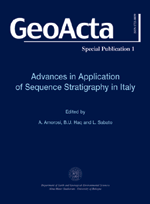Valeria Pancioli1, Barbara Nisi2,1, Francesco Capecchiacci1, Orlando Vaselli1,3, Franco Tassi1,3 and Sandro Moretti 1
1 Department of Earth Sciences, Via G. La Pira 4, 50121 Florence, Italy. Present address: Department of Earth Sciences, Largo E. Fermi 2, 50125 Florence, Italy. E-mail: valeria.pancioli@unifi.it
2 CNR-IGG Institute of Geosciences and Earth Resources, Via G. Moruzzi 1, 56124 Pisa, Italy
3 CNR-IGG Institute of Geosciences and Earth Resources, Via G. La Pira 4, 50121 Florence, Italy
|
|
|
A new approach for evaluating CO2-rich gas discharges as geosites: the Acquabolle (Florence, Italy) case study
|
|
|
|
|
|
|
|
PDF (4,1 MB)
|
Abstract
A geological site of significant importance, namely “Geosite”, in agreement with the newest national and international terminology, represents the “physical land component that constitutes scientific interest, but also has attractive features in terms of landscape component. It can be related to a historic, cultural, educational, recreational and social-economic value”. The administrative and technical bureau of the District of Tuscany (central Italy) has already developed a new policy that tends to protect biodiversity as indicated by the Regional Directive 56/2000, which stresses that GRIs (Geosite of Regional Interest) are to be considered an essential land resource.
In this respect, a master plan to propose the institution of a GRI at Acquabolle (Montespertoli, Florence, central-northern Apennines, Italy) was carried out. The site is enclosed in the Acquabolle Basin, an area of about 1.4 km2 in which a bubbling pool, 3 m in diameter, discharges about 4 tons/day of CO2 with the presence of punctual and diffuse CO2 emission nearby. The master plan was designed to fulfil a protocol based on a multiple approach that considers the following aspects: i) geomorphology, ii) natural sciences, iii) geochemistry, and iv) land use. Moreover, a Regional Data Sheet, utilized for the identification of Italian Geosites, was improved to fit the characteristics of the Acquabolle area.
Although the CO2-rich Acquabolle gas emissions can be regarded as small size gas discharge, visual observations and the analytical results highlight the necessity to control the access to the site, particularly nearby the main Acquabolle gas pool where the CO2 manifestation is indeed relatively powerful and potentially dangerous also for humans, as proved by the occasional presence of dead animals in a slightly depressed area close the gas pool where CO2 tends to overflow. Furthermore, plants and animals adaptation suggests evolutionary adaptive responses, pinpointing the scientific importance of the site.
Keywords: CO2-rich gas discharges, Montespertoli, Central Italy, Geosite, Gas geochemistry
|
|


